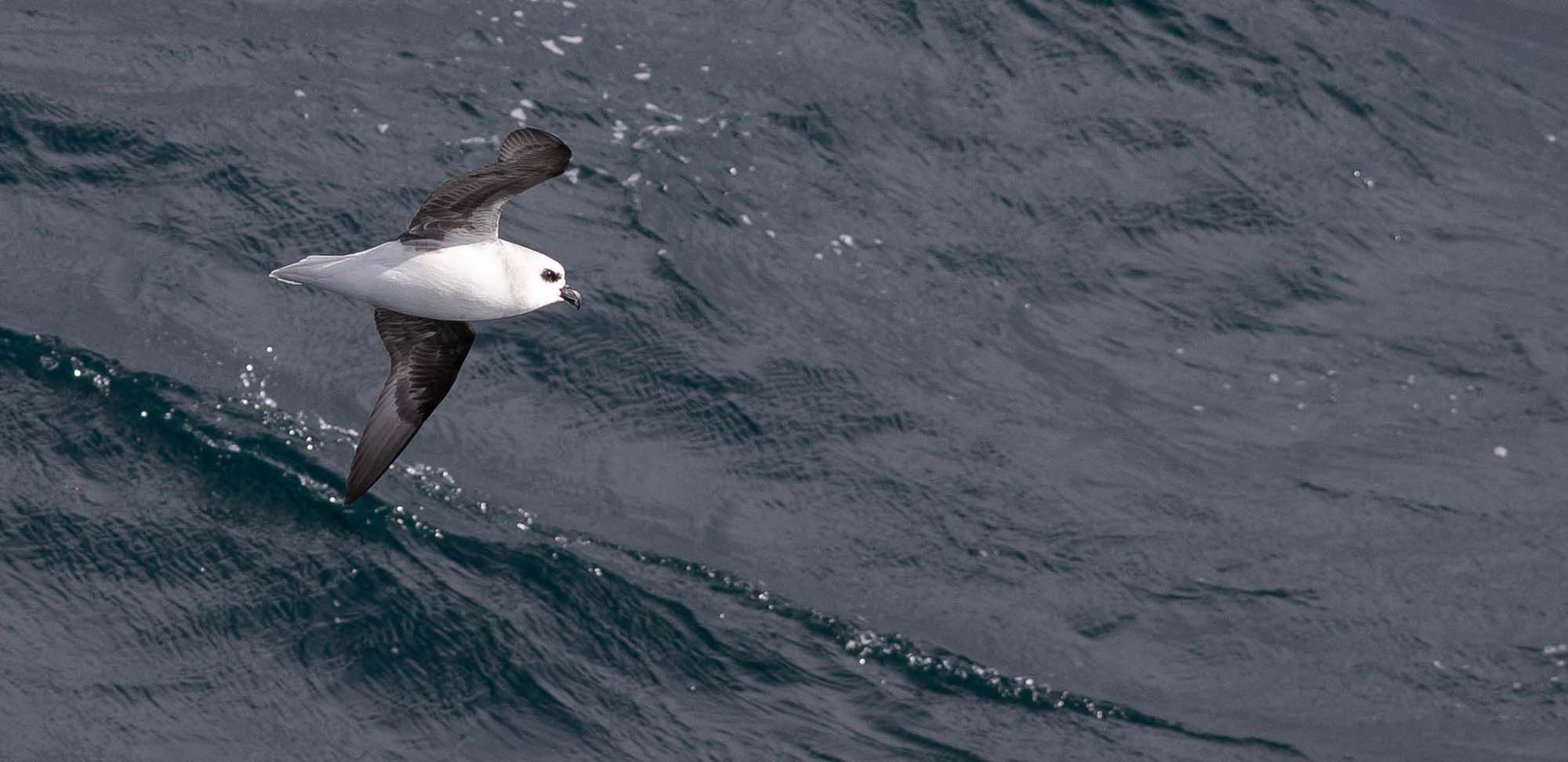Each year, expedition ships re-position themselves from the Antarctic to the Arctic, and this offers a once-a-year opportunity to explore seldom-visited swaths of the central Atlantic Ocean, including some of the most remote islands on Earth. Taking advantage of this opportunity again, we'll embark at Ushuaia, at the southern tip of South America, and our cruise will start off with a visit to the breathtaking shores of South Georgia Island, one of the Antarctic region's gems. South Georgia is considered by many to be the most important seabird breeding island on the planet, featuring an astounding number of nesting penguins and tubenoses.
Before South Georgia, however, we'll have three exciting days at sea with lots of seabirding potential as we leave Tierra del Fuego and cross through the Antarctic Convergence and into the cold, productive waters surrounding South Georgia. In addition to Slender-billed (and then Antarctic, as we go south) Prions, White-chinned Petrels, Black-browed Albatrosses, Soft-plumaged and Cape petrels, and other species, we will be keeping an eye out for scarcer seabirds of cold waters such as Blue Petrel, and as we approach South Georgia we'll focus especially on separating the similar South Georgia and Common diving-petrels from one another.
After not seeing land for a couple of days, we'll find the shockingly steep cliffs that form the spine of South Georgia to be a welcome sight. In the shadow of these mountains, there are beaches littered with Antarctic Fur Seals and, just beyond them, the colonies of King Penguins stretching out of sight; at the end of the Antarctic summer, these will be bustling with activity. We'll spend three days exploring various sections of South Georgia, and we'll plan to make multiple landings on the island, getting up close and personal with King Penguins, Wandering Albatross, South Georgia Pintail, and even the southernmost breeding passerine in the world--South Georgia Pipit. We'll have the opportunity to visit one or more colonies of King Penguins numbering into the hundreds of thousands, and some of our explorations (perhaps a Zodiac cruise in Cooper Bay) will bring us into the realm of the cliff-and-crevice-nesting Macaroni Penguins. We will also visit Grytviken, the old whaling station on South Georgia which is now a tourist-equipped site complete with museum and post office. While at Grytviken, we'll pay our respects to the legendary explorer Ernest Shackleton, buried in the small cemetery there.
From South Georgia we'll set off northward into the Atlantic. These at-sea days in between islands will present a unique opportunity to sample seldom-seen pelagic birds and mammals in the environment where they spend the majority of their lives. If you want to spice up your experience, these crossings will also feature interesting lectures from expedition staff, as well as some crew-led astronomy observations (as sky conditions permit), to intersperse with your exciting pelagic seawatching. Some of the more common seabirds on the crossing could be the longest-winged bird in the world, Wandering Albatross, and the gorgeous Light-mantled Albatross, as well as Black-browed Albatross, Antarctic Prion, both species of giant-petrels, White-chinned Petrel, Soft-plumaged Petrel, Black-bellied Storm-Petrel, and diving-petrels. We'll also be on the lookout for less densely distributed species such as Sooty Albatross, Great-winged Petrel, White-headed Petrel, Atlantic Petrel, Kerguelen Petrel, both MacGillivray's and Broad-billed prions, and Subantarctic Shearwaters. Many of these will increase in number and frequency as we approach the remote islands of Tristan da Cunha, and we'll keep our eyes out for such prizes as Tristan Albatross and Spectacled Petrel. We'll also have a good chance to see some of the poorly known "white-bellied" Black-bellied Storm-Petrels, including potential future split "Gough Storm-Petrel."
Our next encounters with land will be in the Tristan da Cunha group, the most remote human-inhabited islands on the planet! We will arrive first at Gough Island (pronounced like "Goff"), which, while technically part of the Tristan group, actually lies more than 225 miles to the southeast of the group's other islands and thus has a character all its own. It is considered by some to be the seabird capital of the South Atlantic, as it is home to 20 or more (depending on your taxonomy) species of breeding seabirds, with the number of birds present each year numbering in the millions. This includes about 15 species of tubenoses, among them Tristan Albatross, Sooty Albatross, Kerguelen Petrel, Atlantic Petrel, Great-winged Petrel, Broad-billed and the cryptic MacGillivray's prions, and several taxa of storm-petrel. We will not be landing on the island, which is a World Heritage Site, but we will hope to make a Zodiac cruise near enough to the sheltered side of the island to see the two endemic landbirds here: Gough Bunting and Gough Moorhen. Gough will also be our first exposure to Moseley's Rockhopper Penguins, of which more than 85% of the world population breeds in the Tristan group. We'll continue to be in the restricted range of this middle-of-the-ocean penguin during our time around these islands.
Prying ourselves away from this incredible seabird spectacle, we'll set sail for the eponymous Tristan da Cunha island, the largest and only inhabited island in the group. We'll plan to visit the main settlement on the island, Edinburgh, and meet the locals, with their rich and colorful ancestry, as well as drop in on their (have we mentioned, very remote?!) post office! Tristan hosts the largest colony of Atlantic Yellow-nosed Albatrosses, and while around the main island we should find them in abundance. We should also see Sooty Albatross and Tristan Skuas.
Less than 25 miles to the southwest of Tristan da Cunha lie Nightingale and Inaccessible islands, roughly ten miles apart, and we'll plan to visit both, though our ability to land on the islands will be in the hands of the weather gods. The weather and seas will govern how much of these smaller islands we'll be able to explore--the conditions must be just right to do so. If we cannot land, we'll explore the coastlines by Zodiac or from the ship itself. Some of the endemic landbirds, such as Inaccessible Island Finch, Tristan Thrush, and Nightingale Island Finch, can sometimes be seen without actually landing. If we are able to land on Inaccessible Island, then the coveted Inaccessible Island Rail, tiny and related to Black Rail, is possible, as it is quite common there. If we can land on Nightingale Island, there is some chance we may encounter Wilkins's Finch, which favors the higher elevations. Landings or not, there will be seabirds galore and great vistas to take in around these two strikingly scenic islands.
From Tristan da Cunha we'll continue northward, with another good spate of at-sea days featuring additional exciting pelagic possibilities. Over this stretch we'll trade the unpredictable and often stormy seas of the South Atlantic for the placid climate and quieter waters of the tropical ocean. As we head north into warmer and less productive waters, the number of seabirds will drop off, but we will have a chance for new species, such as Bulwer's Petrel, Band-rumped Storm-Petrel, Red-billed Tropicbird, and Masked Booby. We'll also have new marine life possibilities, as flying fish will be jumping alongside the ship, and if we are very lucky we may encounter one or more species of small whales, dolphins, and beaked-whales.
The final island on our tour will be St. Helena. It is most well known as the place where Napoleon Bonaparte was exiled and where he ultimately died, but this large volcano protruding from the tropical sea between Africa and Brazil does have other things to recommend it. There are breeding colonies of Band-rumped (St. Helena) Storm-Petrels, Red-billed Tropicbirds, Masked and Brown boobies, Black and Brown noddies, and the unique White Tern. We'll also have a chance to see Pantropical Spotted Dolphins, common around the islands. Whale Sharks are also frequent in this area and could provide another highlight. The bird of most interest, however, is the endemic St. Helena Plover (known locally as the Wirebird), the only St. Helena endemic that did not go extinct with the arrival of humans here. In Jamestown we'll have the chance to visit Longwood House (where Napoleon lived his last years) and the Governor's residence. You can also climb above town on the 699-step Jacob's Ladder and visit some of the nearby high peaks, as well as the location where astronomer Edmond Halley (discoverer of Halley's Comet) observed the night sky several hundred years ago.
Although the ship will continue northward, our tour will end here. You can fly home from Jamestown's new airport.
Select the KEY INFO tab or click here for our itinerary plus space requests, status, fees, limits, and guides for any departure.


